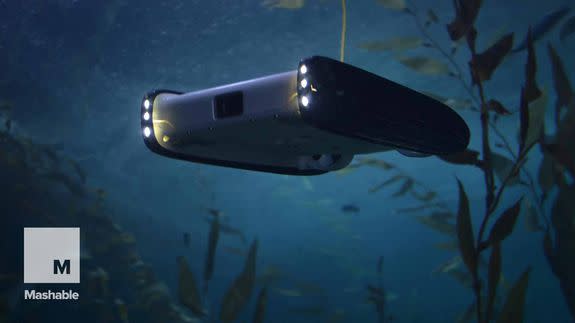This low-cost underwater drone aims to democratize the ocean for wannabe treasure hunters

Treasure hunters and explorers David Lang and Eric Stackpole are creating what they call the world's first low-cost underwater drone.
Back in 2012, Eric told David about gold lost inside an underwater cave in California that was just begging to be found. So, naturally, the two set out on their path becoming millionaires, scheming ways of locating and extracting the hidden treasure.
They knew they couldn't dive deep enough into the cave themselves, so they decided to try a remotely operated vehicle (ROV). But there was nothing on the market that was affordable and accessible.
So David and Eric decided to build their own.
SEE ALSO: Watching orcas swimming in the wild on live cam is why we have internet
First, they set up OpenROV, an open community where all ocean and engineering enthusiasts could critique their ideas and designs and help them better their products.
Now, two hugely successful Kickstarter campaigns later and over 3,000 robots sold worldwide, the openROV cofounders think they finally struck gold with their new, low-cost underwater drone, called the Trident.
In an interview with Mashable, David Lang said the Trident is a simple and affordable way of diving into the unknown and exploring a world never seen by human eyes before. With over 95 percent of the world's oceans remaining unexplored, David says underwater drones like this are the future to scientific research and serious exploration.
But the Trident is also aimed at all the amateur ocean lovers out there. It's remotely controlled via a smartphone, laptop or joystick and can be fitted with a VR headset, turning the idea of virtual reality on its head and offering a part of our own planet that has always remained dark on a silver platter.
"We've had so may people try the [VR headset] and their jaws drop and then go, 'Oooooh.' The experience is really unique and only a few people have had it. And I think the Trident aims to bring that experience to more people," David said.
The Trident sends live HD video feed to the surface by way of a thin, neutrally buoyant tether up to 600 feet long. It weighs around six pounds and is small enough to fit in a backpack. David also said that it moves faster than Michael Phelps.
"It flies like a fighter jet, so if you want to go deep, all you do is point down and you fly straight down. The way that it flies really opens up a lot of different opportunities surveys and covering a lot of ground and really understanding the whole area of a place you wanna explore."
This provides a contrast with aerial drones, which can cover huge areas, but cannot offer the kind of novel insight and detail into our surrounding that something like the Trident can. We have neglected the underwater unknown for too long and the future of drones is below, not above is.
You can pre-order your own personal submarine for $1,199.
